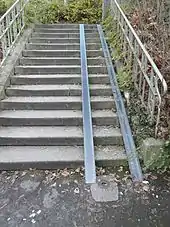



A bicycle stairway is a pedestrian stairway which also has a channel alongside it to facilitate walking a bicycle up or down the stairway.[1]
The channel itself is also often called a wheeling ramp, push ramp or runnel. There is no standard in the dimensions, materials, or shape used in the channel, however the channel is intended to be sufficient to guide a variety of bicycle tires without binding or causing damage. Cross-section shapes vary, but are usually either nearly rectangular or V- or U-shaped. Depth is generally 2 to 6 cm (1 to 2.5 inches) and width 6 to 13 cm (2.5 to 5 inches). If the stairs do not turn and are relatively short, a flat cross section without sidewalls may suffice. The channel is an inclined plane within easy reach of someone using the stairs. There may be level portions for resting or passing. While most examples of existing bicycle stairs feature permanent or built-in channels, Oregon Health & Science University has invested in the development of a modular, after-market, retrofitting "bicycle gutter" device that was awarded patents in 2011[2] and 2012.[3]
Accessibility requirements for handrails tend to conflict with bicycle stairways, as handrails may obstruct or decrease the control of a bicyclist using the channel. Suggestions for resolving the conflicts include providing a single handrail down the middle of the stairs with gutters at the outside edges, or placing handrails at both edges and placing the gutter in the middle.[4] However, the Toronto Transit Commission is testing channels placed next to handrails. Some users have commented about the disadvantages, such as pedals catching on the stairs' handrail.[5]
Bicycle stairways may have arisen in reaction to wear and compaction beside outdoor stairways where people preferred to roll their bicycle on smooth lawn or soil instead of carrying it or having it bump along the stairs.[6]
See also
- Bicycle escalator (a powered version of a bicycle staircase)
- Cycling infrastructure
References
- ↑ R. Houston (August 13, 2001). "(unknown)" (PDF). Institute of Transportation Engineers. pp. 144–146. Retrieved 2008-12-08.
{{cite web}}: Cite uses generic title (help) - ↑ Christopher Woo, Gary Granger (September 27, 2011). "United States Patent: D646043". Retrieved 2014-06-04.
- ↑ Christopher Woo, Gary Granger (December 18, 2012). "United States Patent: 8332981". Retrieved 2014-06-04.
- ↑ McKenna Associates, Inc. (August 13, 2001). "Mason Bicycle and Pedestrian Way Master Plan" (PDF). City of Mason, Ohio. p. 66. Retrieved 2008-12-08.
- ↑ Marc Lostracco (February 27, 2008). "Stair Decisis". Torontoist. Retrieved 2009-03-12.
- ↑ A. Richard Miller (August 23, 2002). "Bicycle Stairs". Retrieved 2008-12-08.
External links
- Photo of a flat cross section at a train station in Japan